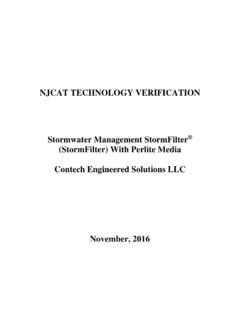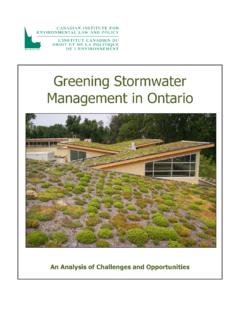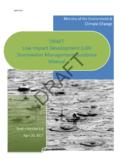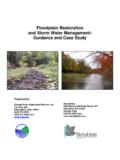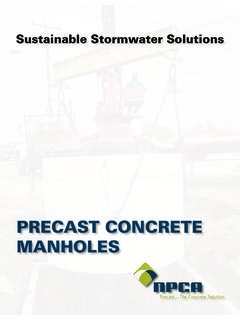Transcription of NEW! Stormwater Attenuation Systems - Klar …
1 Pollution Control NE. W! Stormwater Attenuation Systems Sustainable Urban Drainage solutions for Domestic & Commercial Applications Stormwater Attenuation Systems Sustainable Urban Drainage solutions for Domestic & Commercial Applications Sustainable Urban Drainage Managing the Stormwater Challenge Systems (SUDS). As more river valleys become developed with hard To address this problem, the drainage Systems of towns, cities surfaces (paths, roads and roofed areas) the volume and developments have been surveyed and a policy of of rainwater that runs off the land increases. Sustainable Urban Drainage Systems (SUDS) has been developed to counteract the problems being encountered.
2 This can have a severe effect in a watercourse where flash SUDS addresses issues of the quantity and quality floods can occur downstream where the volume of water of the water run-off from sites. Attenuation Systems (tanks entering the system can be extremely high due to a cumulative and rainwater harvesting Systems ) and separators (to effect of development upstream. remove oil contaminants from discharges) are required. Global warming has also had an impact on the level of To size the Systems required, the flow rate from the rainfall, which has gradually increased over the past few development is calculated from rainfall records and the decades. This has accentuated the problem of Stormwater run-off rate for a particular type of surface, roadway, entering waterways.
3 Roofed area, grassed area, all of which allow surface water Flash floods along with rising sea levels have been to run off at different rates. The design is normally based responsible for some severe flooding in the UK in recent on the highest recorded rainfall in the previous 30 years, years. This has led to rising insurance claims and leaving but this can vary. some areas as blackspots where insurance against flood Most authorities limit the amount of rainfall run-off from a damage cannot be obtained. development to a level where the rate does not exceed the rate of discharge from a green field site (5 litres/sec/acre approx.) but this must be specified by the local authorities.
4 A technical engineer should provide the design calculations for the surface water run-off in order to size a system . This should also include the flow rate allowed for discharge to a watercourse, and the required storage volume. How Does An Attenuation system Work? When the peak inflow rate in a storm exceeds the allowed discharge into the watercourse, the excess flow has to be attenuated' on the site for the duration of the storm. This is then released at, or less than, the allowed discharge rate after Government Policy the storm. & Building Regulations To store the excess volume and allow the correct discharge Building Regulations Part H3 rate to go to the watercourse, a flow regulator is installed to Planning Policy Statement 3 (PPS3) bleed off' the correct maximum flow rate.
5 The flow regulator Planning Policy Statement 25 (PPS25) can be a vortex type system or a simple orifice plate system . CIRIA publications: The SUDS manual (C697)' and The remainder of the water is stored either in-line or Site handbook for the construction of SUDS (C698)' off-line, depending on the design. 2. In-Line Attenuation Tanks In-line Systems allow the water to back up through the tank and drain by gravity through the flow regulator. This system is normally used for installations where a fall through the system of metres (on a sloped site) can be accommodated. In-line Orifice Tank system An orifice plate system works on the principle that the pressure created at a particular head will result in a particular flow based on the head versus hole size.
6 This is a simple and inexpensive system . In-line Vortex Tank system A vortex flow regulator works on the principle of inducing a rotating flow around an opening at a high speed to limit the outflow of the liquid. This is the same principle that can be seen in a bath as it empties; the vortex reduces the flow from the bath even though there is a high head. 3. Off-Line Attenuation Tank Off-line tank Systems have the flow regulator in a separate chamber and allow the flow to build up and overspill into a storage tank, or tanks, adjacent to the chamber. Off-line Tank system (patent applied for). The storage tank is emptied using pumps which are activated when the level in the regulating chamber recedes after the storm.
7 This system gives a shallow inlet to outlet dimension and can cater for larger flows. Separators Removing Pollutants from Surface Water Run-off Surface water drains normally discharge to a watercourse or indirectly into underground waters (groundwater) via a soakaway. Contamination of Full range to cover flow rates from 3 ltr/s up to 130. surface water by oil, chemicals or suspended solids can (Bypass) and 200 ltr/s (Full Retention). cause these discharges to have a serious impact on the Full Retention Separator - treats the full flow receiving water. delivered by the drainage system Separators do not provide Attenuation . They are designed to Bypass Separator - fully treats all flows generated be installed within surface water drainage Systems to protect by rainfall rates up to Attenuation Systems and receiving waters from pollution by oil.
8 Class I and II designs - Class II units meet discharge This may be present due to minor leaks from vehicles or plant, to foul sewer or from accidental spillage. Fully certified to EN 858-1 standards and compliant to PPG3. Separators should be installed upstream of the Attenuation system to protect it from contamination by hydrocarbons. For further information please request a copy of the Klargester Separators brochure. 4. Rainwater Harvesting Systems Utilising a Free Resource from the Roof Rainwater harvesting Systems takes the captured water from a Rainwater Harvesting has many advantages over other forms buildings roof area and uses it for internal non-potable of Attenuation by delivering a number of tangible benefits applications such as toilet flushing.
9 The system stores the including: water in an underground tank rather than allowing the rainfall Commercial properties can reduce their mains water to otherwise soak into the ground, evaporate or enter the consumption by up to 85%. drainage system . Recycled water applications include washing, toilet flushing, irrigation, etc. Utilises buildings' existing infrastructure Minimal installation requirements Rapid payback period on purchase costs on commercial sites For further information please request a copy of the Klargester Envireau Rainwater Harvesting brochure. 5. Advice & Information Selecting the Right Solution Sustainable Drainage Systems encompass much more than just installing a single product.
10 The objective is to deal with the flow at source rather than traditional techniques that simply transfer the problem further down the drainage system . Each site should be tackled with management and control measures designed to meet many of the following objectives: Control and management of Stormwater run-off Reduce the impact of urbanisation Ensure the protection and enhancement of local water quality Enhancing the natural recharge of groundwater Reusing Stormwater to reduce load on local resources Natural integration to the local environment The Klargester range of Attenuation products have been engineered not only as process solutions , but also to offer the user a modular system that incorporates the best practice in SUDS design.
